Abstract
Pulmonary blood volume was determined by the radiocardiographic technique in 49 patients coming to cardiac catheterization. Since this method has not been directly compared with the more commonly used double injection of dye. 25 comparisons were carried out in 13 patients of the series. Agreement was good over a range of 4.5-21.1 heart cycles since there was no statistically significant difference between transit time values measured by the two methods.
The relation of pulmonary blood volume to other hemodynamic factors in these 49 patients, with and without cardiac or pulmonary disease, was evaluated by means of multiple regression analysis. The analysis carried out for mean transit time indicates that this parameter varies predominately with flow. Pulmonary blood volume, in this series of resting recumbent individuals, varies to a significant degree only with total blood volume and with pulmonary venous pressure. No parameters of vascular distensibility, such as pulmonary vascular resistance, were found to affect the volume of blood in the lungs.
The fact that variations in pulmonary blood volume among the subjects could be described by a multiple regression equation linear with respect to total blood volume and pulmonary venous pressure indicates that these variations are the result of passive distention of components of the vascular bed.
Full text
PDF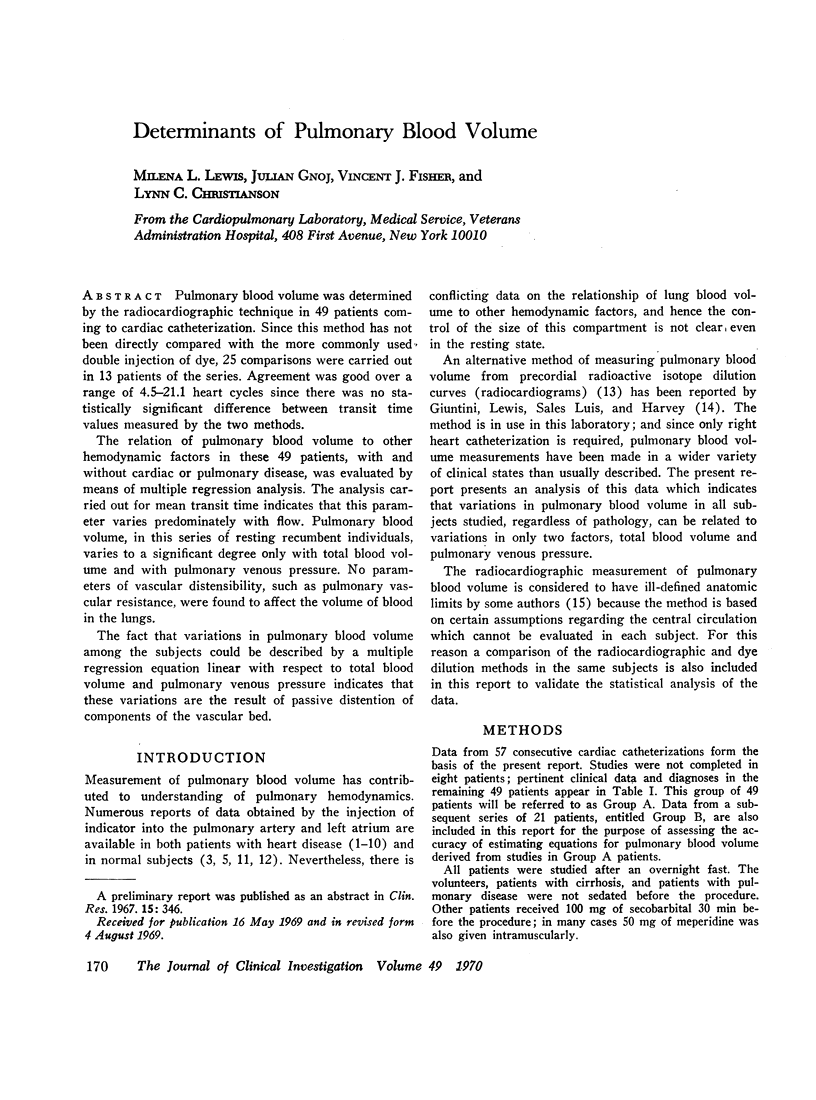
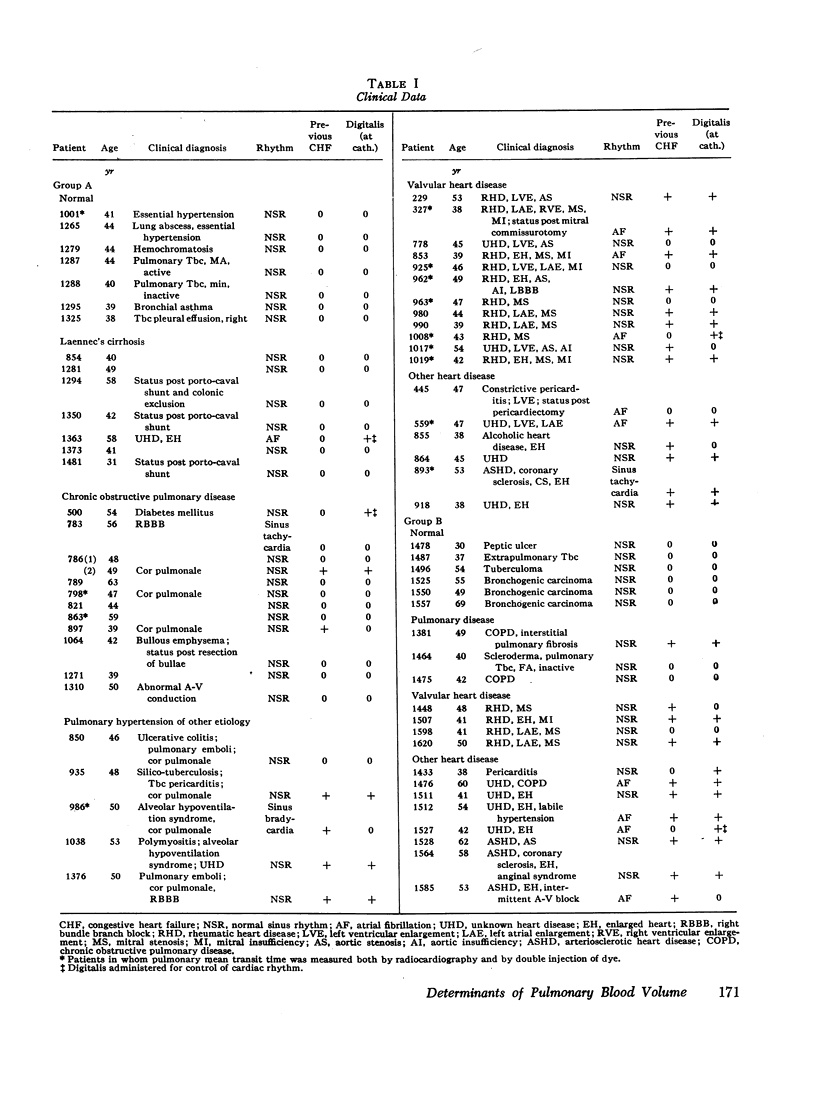
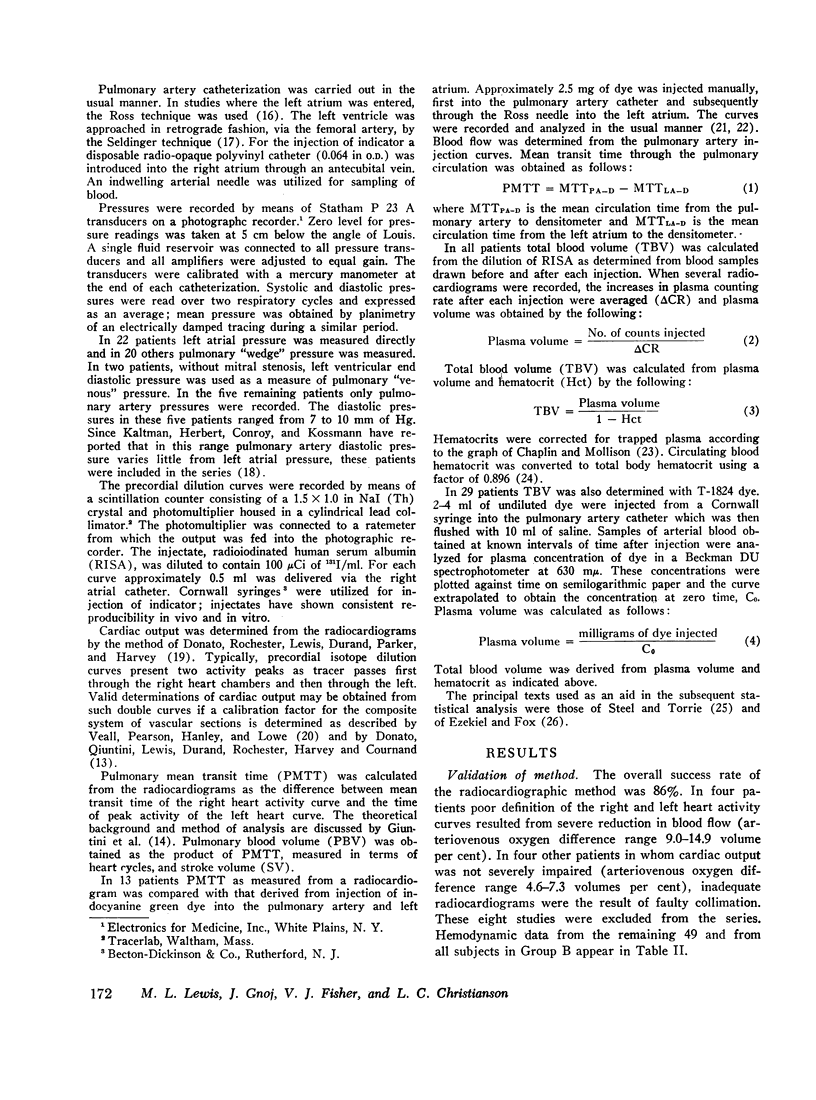
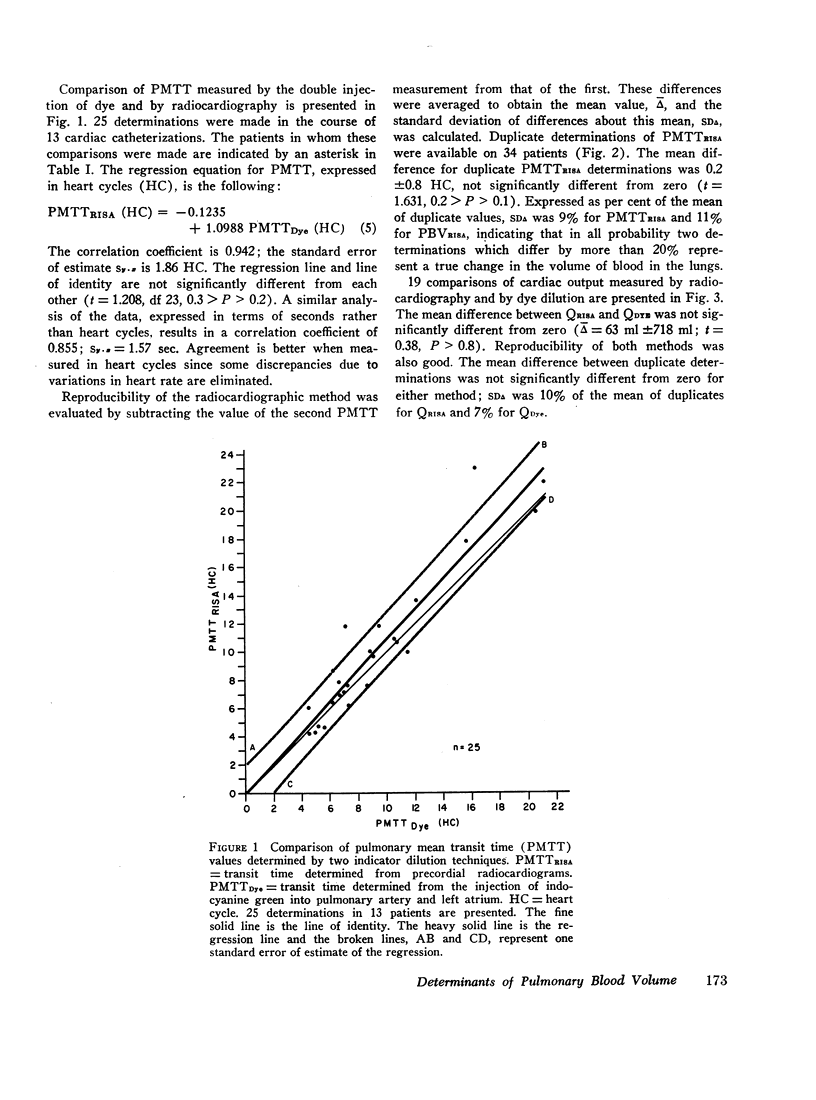
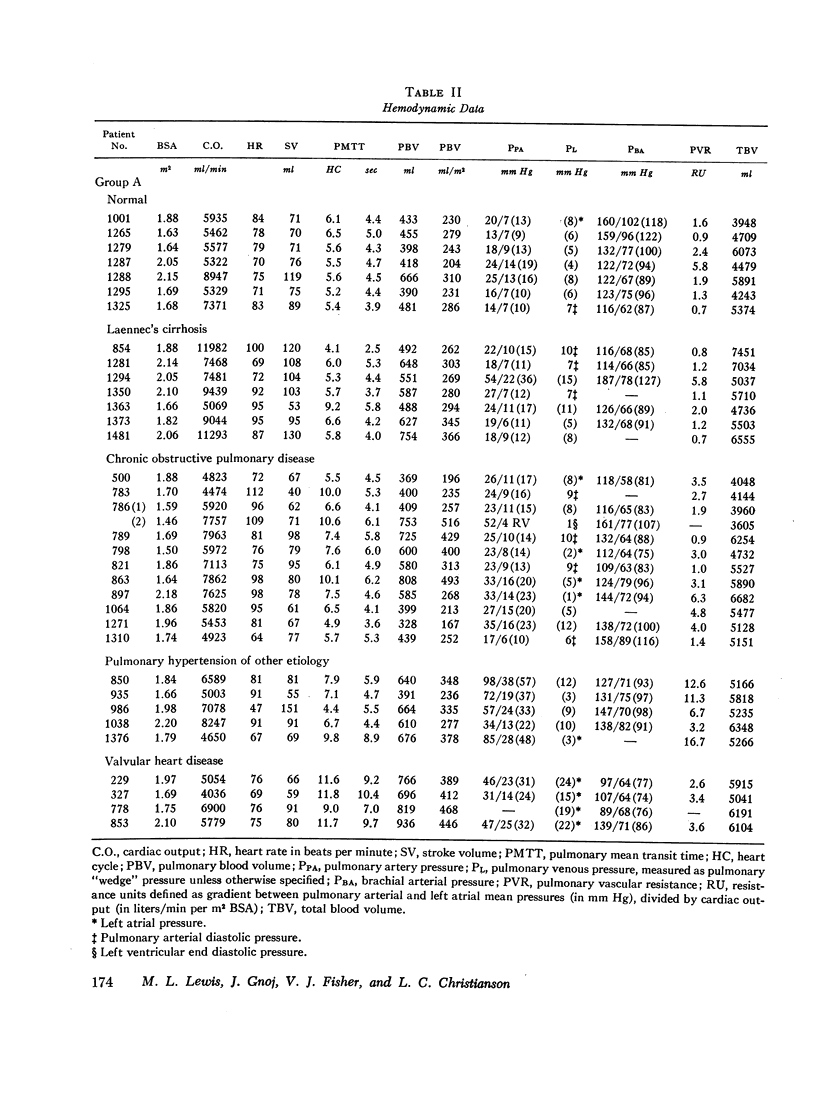
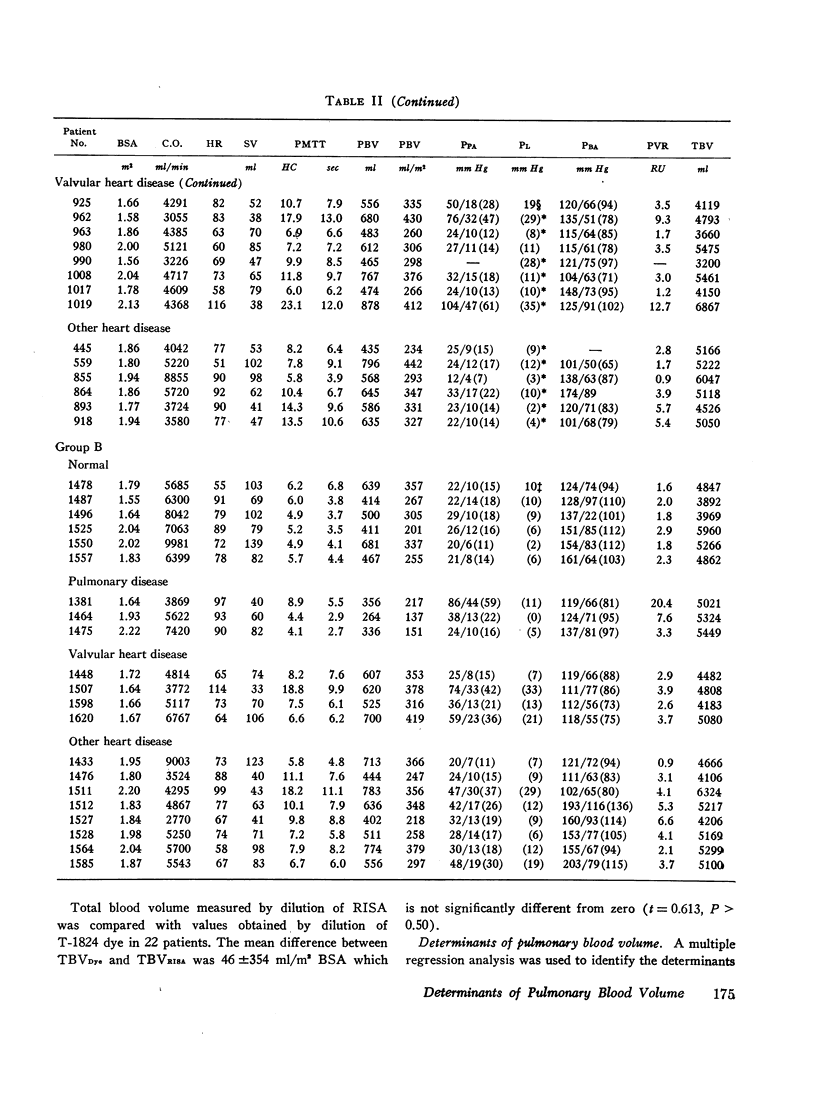
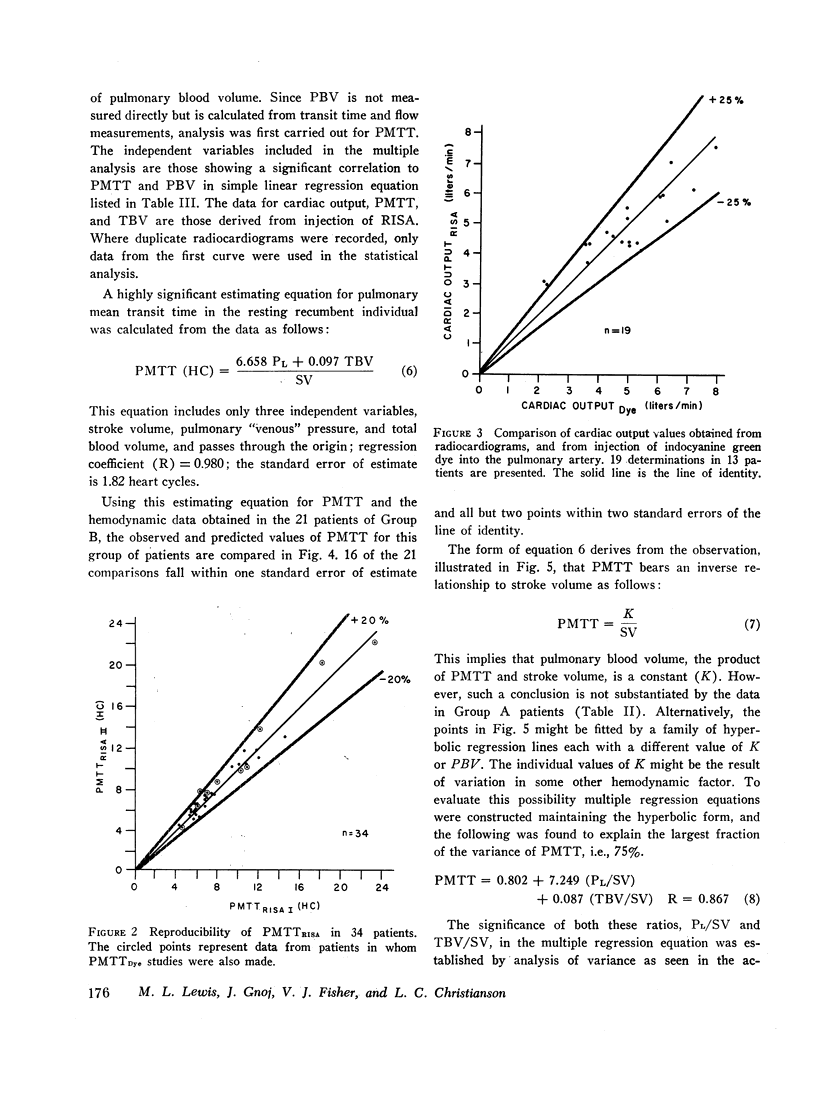
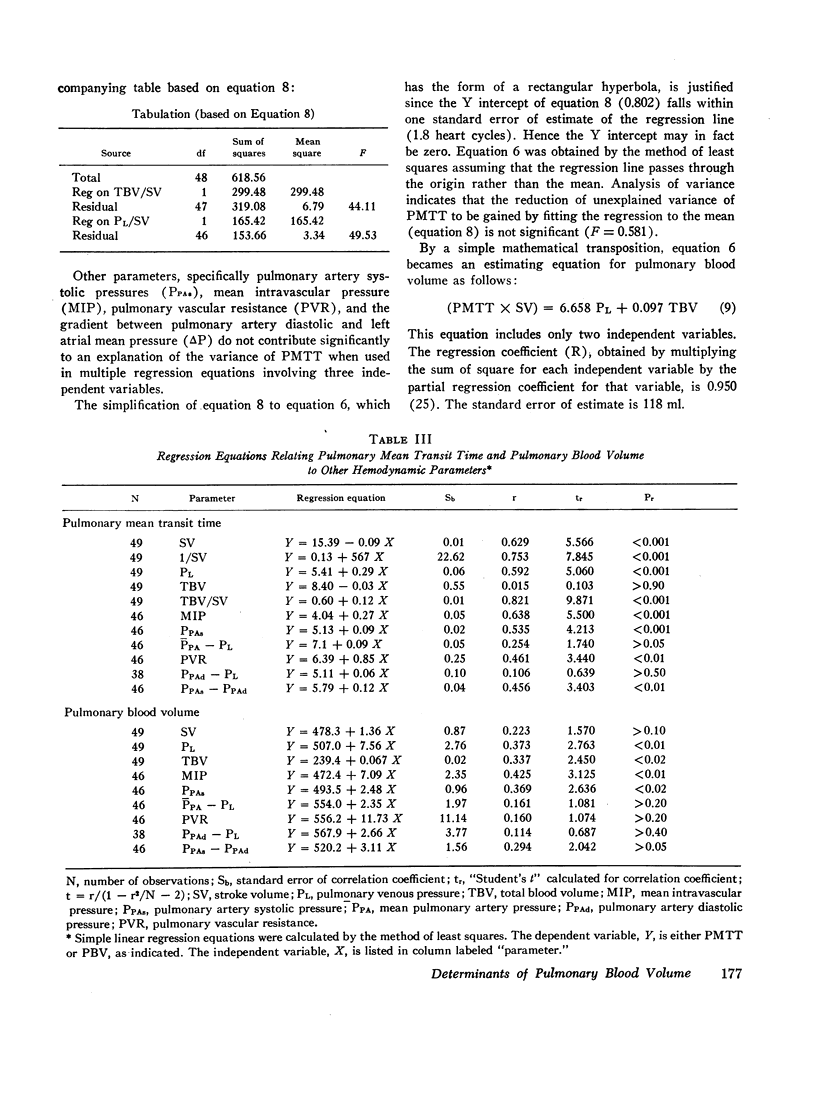
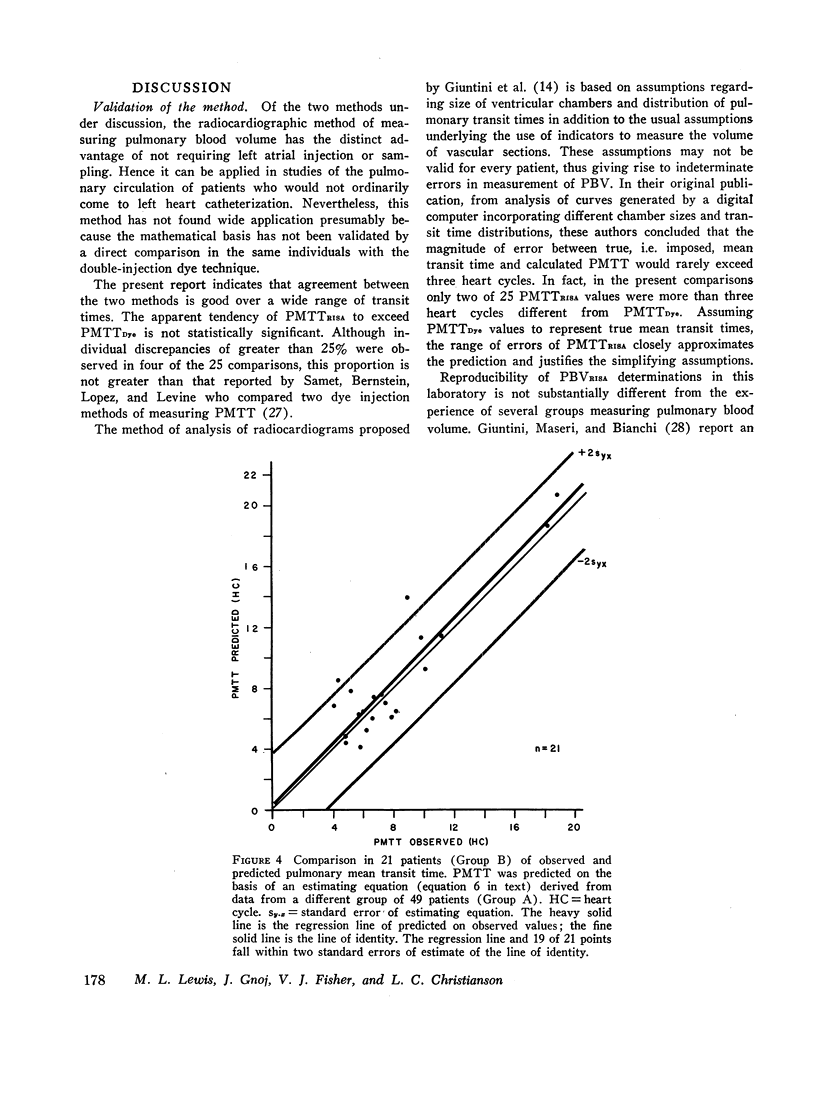
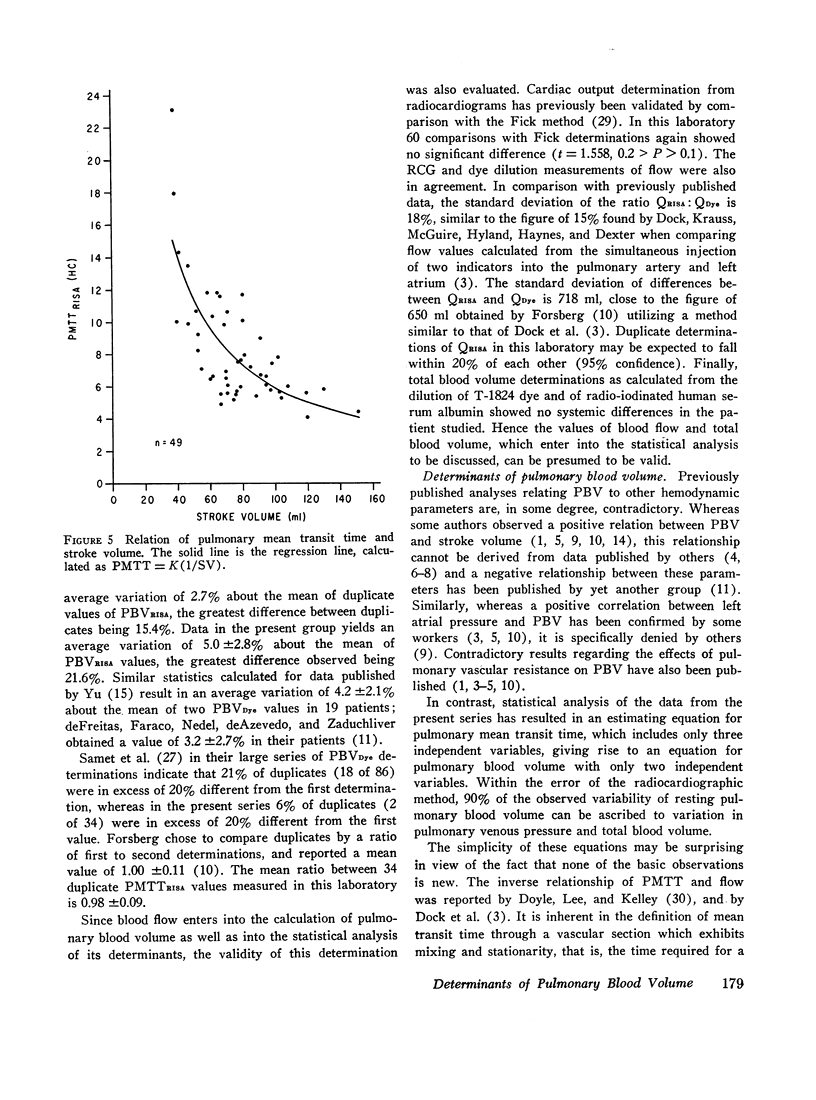
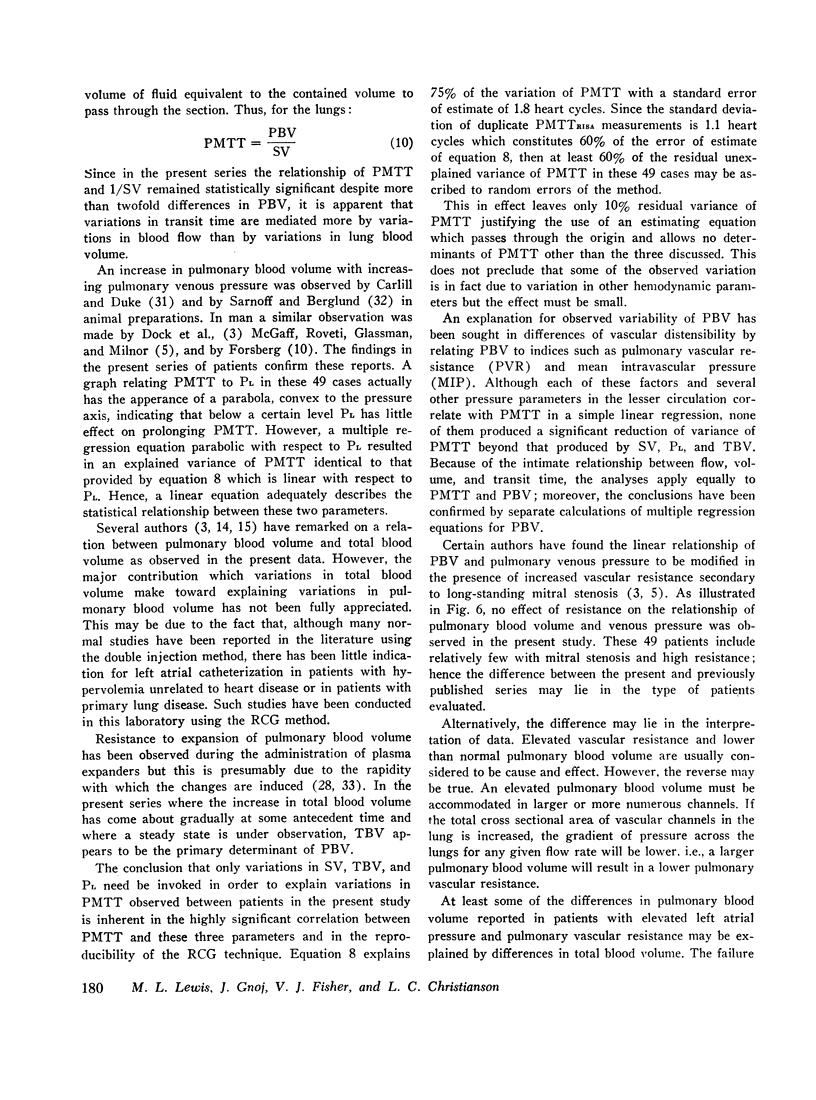
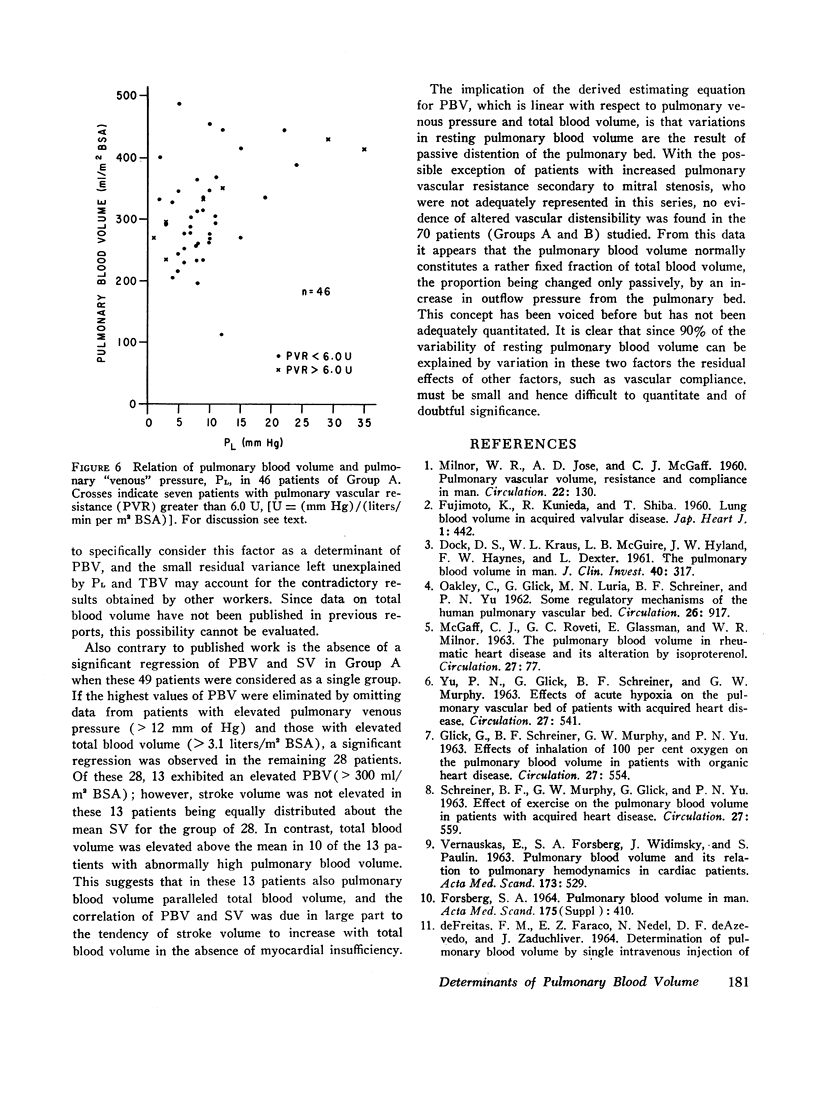
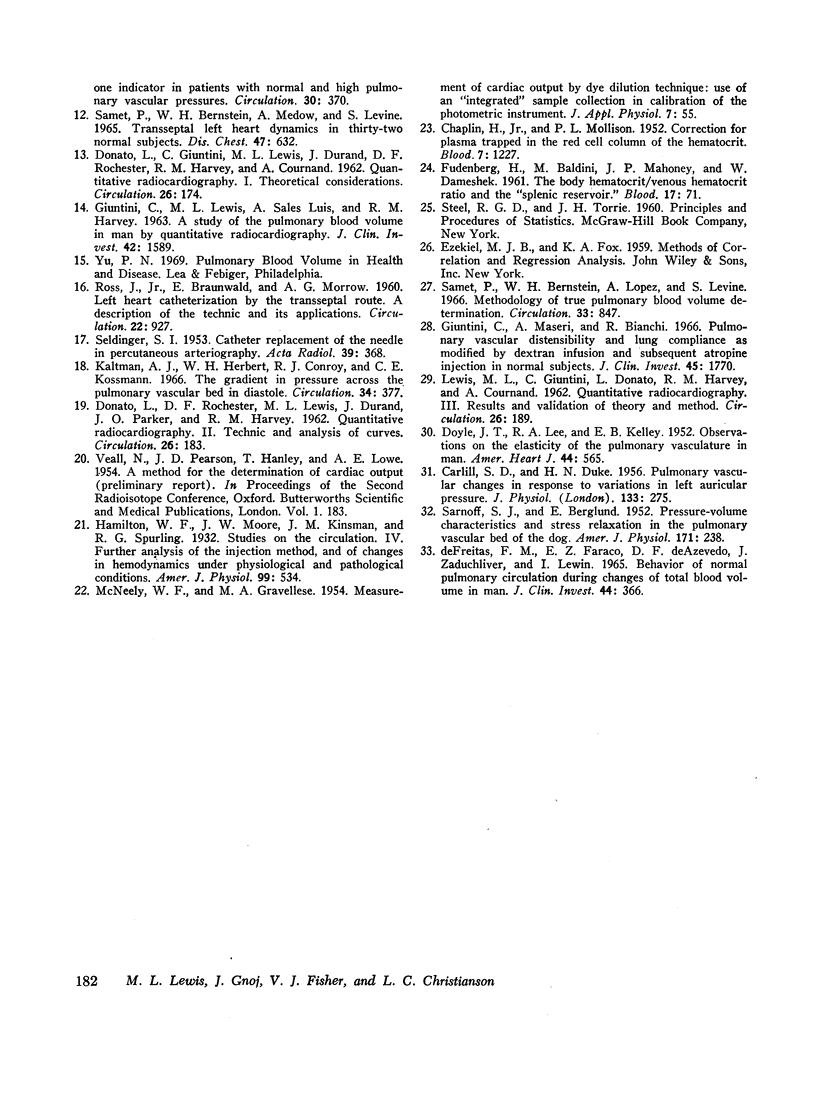
Selected References
These references are in PubMed. This may not be the complete list of references from this article.
- CARLILL S. D., DUKE H. B. Pulmonary vascular changes in response to variations in left auricular pressure. J Physiol. 1956 Aug 28;133(2):275–286. doi: 10.1113/jphysiol.1956.sp005585. [DOI] [PMC free article] [PubMed] [Google Scholar]
- CHAPLIN H., Jr, MOLLISON P. L. Correction for plasma trapped in the red cell column of the hematocrit. Blood. 1952 Dec;7(12):1227–1238. [PubMed] [Google Scholar]
- DE FREITAS F. M., FARACO E. Z., DE AZEVEDO D. F., ZADUCHLIVER J., LEWIN I. BEHAVIOR OF NORMAL PULMONARY CIRCULATION DURING CHANGES OF TOTAL BLOOD VOLUME IN MAN. J Clin Invest. 1965 Mar;44:366–378. doi: 10.1172/JCI105150. [DOI] [PMC free article] [PubMed] [Google Scholar]
- DEFREITAS F. M., FARACO E. Z., NEDEL N., DEAZEVEDO D. F., ZADUCHLIVER J. DETERMINATION OF PULMONARY BLOOD VOLUME BY SINGLE INTRAVENOUS INJECTION OF ONE INDICATOR IN PATIENTS WITH NORMAL AND HIGH PULMONARY VASCULAR PRESSURES. Circulation. 1964 Sep;30:370–380. doi: 10.1161/01.cir.30.3.370. [DOI] [PubMed] [Google Scholar]
- DOCK D. S., KRAUS W. L., McGUIRE L. B., HYLAND J. W., HAYNES F. W., DEXTER L. The pulmonary blood volume in man. J Clin Invest. 1961 Feb;40:317–328. doi: 10.1172/JCI104259. [DOI] [PMC free article] [PubMed] [Google Scholar]
- DONATO L., GIUNTINI C., LEWIS M. L., DURAND J., ROCHESTER D. F., HARVEY R. M., COURNAND A. Quantitative radiocardiography. I. Theoretical considerations. Circulation. 1962 Aug;26:174–182. doi: 10.1161/01.cir.26.2.174. [DOI] [PubMed] [Google Scholar]
- DOYLE J. T., LEE R. A., KELLEY E. B. Observations on the elasticity of the pulmonary vasculature in man. Am Heart J. 1952 Oct;44(4):565–570. doi: 10.1016/0002-8703(52)90195-6. [DOI] [PubMed] [Google Scholar]
- FUDENBERG H., BALDINI M., MAHONEY J. P., DAMESHEK W. The body hematocrit/venous hematocrit ratio and the "splenic reservoir". Blood. 1961 Jan;17:71–82. [PubMed] [Google Scholar]
- GIUNTINI C., LEWIS M. L., LUIS A. S., HARVEY R. M. A STUDY OF THE PULMONARY BLOOD VOLUME IN MAN BY QUANTITATIVE RADIOCARDIOGRAPHY. J Clin Invest. 1963 Oct;42:1589–1605. doi: 10.1172/JCI104844. [DOI] [PMC free article] [PubMed] [Google Scholar]
- GLICK G., SCHREINER B. F., Jr, MURPHY G. W., YU P. N. Effects of inhalation of 100 per cent oxygen on the pulmonary blood volume in patients with organic heart disease. Circulation. 1963 Apr;27(4 Pt 1):554–558. doi: 10.1161/01.cir.27.4.554. [DOI] [PubMed] [Google Scholar]
- Giuntini C., Maseri A., Bianchi R. Pulmonary vascular distensibility and lung compliance as modified by dextran infusion and subsequent atropine injection in normal subjects. J Clin Invest. 1966 Nov;45(11):1770–1789. doi: 10.1172/JCI105482. [DOI] [PMC free article] [PubMed] [Google Scholar]
- Kaltman A. J., Herbert W. H., Conroy R. J., Kossmann C. E. The gradient in pressure across the pulmonary vascular bed during diastole. Circulation. 1966 Sep;34(3):377–384. doi: 10.1161/01.cir.34.3.377. [DOI] [PubMed] [Google Scholar]
- MILNOR W. R., JOSE A. D., MCGAFF C. J. Pulmonary vascular volume, resistance, and compliance in man. Circulation. 1960 Jul;22:130–137. doi: 10.1161/01.cir.22.1.130. [DOI] [PubMed] [Google Scholar]
- McGaff C. J., Roveti G. C., Glassman E., Milnor W. R. Pulmonary blood volume in rheumatic heart disease and its alteration by isoproterenol. Circulation. 1963 Jan;27:77–84. doi: 10.1161/01.cir.27.1.77. [DOI] [PubMed] [Google Scholar]
- McNEELY W. F., GRAVALLESE M. A., Jr Measurement of cardiac output by dye dilution technique: use of an integrated sample collection in calibration of the photometric instrument. J Appl Physiol. 1954 Jul;7(1):55–58. doi: 10.1152/jappl.1954.7.1.55. [DOI] [PubMed] [Google Scholar]
- OAKLEY C., GLICK G., LURIA M. N., SCHREINER B. F., Jr, YU P. N. Some regulatory mechanisms of the human pulmonary vascular bed. Circulation. 1962 Nov;26:917–930. doi: 10.1161/01.cir.26.5.917. [DOI] [PubMed] [Google Scholar]
- SAMET P., BERNSTEIN W. H., MEDOW A., LEVINE S. TRANSSEPTAL LEFT HEART DYNAMICS IN THIRTY-TWO NORMAL SUBJECTS. Dis Chest. 1965 Jun;47:632–635. doi: 10.1378/chest.47.6.632. [DOI] [PubMed] [Google Scholar]
- SARNOFF S. J., BERGLUND E. Pressure-volume characteristics and stress relaxation in the pulmonary vascular bed of the dog. Am J Physiol. 1952 Oct;171(1):238–244. doi: 10.1152/ajplegacy.1952.171.1.238. [DOI] [PubMed] [Google Scholar]
- SCHREINER B. F., Jr, MURPHY G. W., GLICK G., YU P. N. Effect of exercise on the pulmonary blood volume in patients with acquired heart disease. Circulation. 1963 Apr;27(4):559–564. doi: 10.1161/01.cir.27.4.559. [DOI] [PubMed] [Google Scholar]
- SELDINGER S. I. Catheter replacement of the needle in percutaneous arteriography; a new technique. Acta radiol. 1953 May;39(5):368–376. doi: 10.3109/00016925309136722. [DOI] [PubMed] [Google Scholar]
- Samet P., Bernstein W. H., Lopez A., Levine S. Methodology of true pulmonary blood volume determination. Circulation. 1966 Jun;33(6):847–853. doi: 10.1161/01.cir.33.6.847. [DOI] [PubMed] [Google Scholar]
- VARNAUSKAS E., FORSBERG S. A., WIDIMSKY J., PAULIN S. Pulmonary blood volume and its relation to pulmonary hemodynamics in cardiac patients. Acta Med Scand. 1963 May;173:529–538. doi: 10.1111/j.0954-6820.1963.tb17437.x. [DOI] [PubMed] [Google Scholar]
- YU P. N., GLICK G., SCHREINER B. F., Jr, MURPHY G. W. Effects of acute hypoxia on the pulmonary vascular bed of patients with acquired heart disease. Circulation. 1963 Apr;27(4):541–553. doi: 10.1161/01.cir.27.4.541. [DOI] [PubMed] [Google Scholar]


